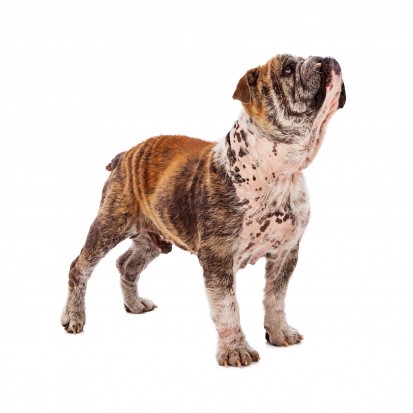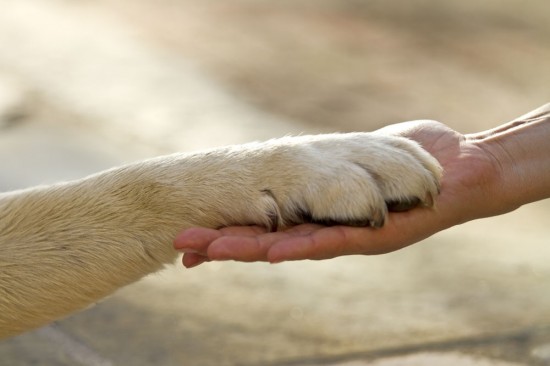

Demodectic mange is a parasitic skin condition caused by the Demodex canis mite. It is immune mediated, and most common in puppies. Older dogs with impaired immunity may also be affected.
Almost all dogs carry the Demodex canis mite and it does not generally cause them any problems unless it proliferates.
Puppies with vulnerable immunity are most at risk, but older dogs can also be affected if the immune system cannot control the mite population. Older dogs who have been prescribed long-term corticosteroids or other immune-suppressing drugs have greater vulnerability too. Demodectic mange in adult dogs is called “ adult onset demodicosis”.
The symptoms of demodectic mange may include:-
Any case of demodectic mange warrants veterinary intervention because it is important to rule out any immune mediated medical condition that may be compromising the body’s defences. Secondary infection is common and will require appropriate antibacterial therapy, and topical treatments applied to the skin will eradicate the mite population promoting a speedier recovery. Localised demodectic mange (cases where there are less than 5 patches of affected skin) in puppies does often rectify itself with a matter of months, but in some cases it can become generalised (affecting a significant proportion of the skin) which can be painful and debilitating.
Demodectic mange is diagnosed by means of a skin scrape or skin biopsy. They cannot simply be brushed onto a slide or identified by means of a hair pluck because they reside buried inside the hair follicles and oil glands where they feed. Demodex mites are too small to be seen with the naked eye, but these little cigar shaped parasites can be seen under the microscope. As mentioned, it is usual for dogs to carry a certain number of these mites, but if their population is greater than normal and skin lesions are present too, this confirms the diagnosis.
Additional tests may be required if concurrent or related conditions are suspected.
Localised demodectic mange in puppies may not require treatment providing the pup is not uncomfortable and there is no secondary infection present. There are several different treatments available for demodectic mange, and your vet will select the most appropriate therapy for the individual dog or puppy. The 2 most common treatments are briefly described below.
Firstly, your vet may clip, or ask you to clip your dog’s hair from the affected regions.
A strong shampoo called Aludex be prescribed. Several applications are usually necessary at fortnightly intervals. It is very important to wear gloves and ensure the room is well ventilated when handling amitraz (which is the active ingredient in this preparation). Monitor your dog closely as some animals may become sleepy or nauseous during the procedure. If this is the case, notify your vet straight away.
Ivomec is a liquid preparation that also requires a reasonably long treatment period. The active ingredient in this medication is ivermectin. Ivermectin must not be administered to Collies or similar breeds.
Antibiotics will be necessary if there is any secondary infection present.
Demodectic mange is not classed as a “nutritionally” responsive condition, but good nutrition that your dog or puppy can digest easily will support the immune system and can only be of benefit. Nutrients which have particular benefit to the skin and coat include:-
Protein provides the building blocks which make up hair. It is also an important component of the skin cells (along with fat). Protein sources for dogs need to be of a high biological value – which means that they are easily broken down into their constituent amino acids. They also need to be high quality (highly bioavailable) so that they are easily digested, and nutritionally valuable. Excellent sources for dogs include eggs, fish, poultry and lamb.
Fats are incorporated into skin cells as fatty acids. Linoleic acid is an omega-6 essential polyunsaturated fatty acid that forms the lipid component of all cell membranes. The omega-3s have many health benefits, but in this context they are best recognised for their natural anti-inflammatory properties. Fish oil is an excellent natural source of the omega-3 fatty acids DHA and EPA.
Vitamin C is an important dietary antioxidant. It is essential for the synthesis of collagen and is necessary for healthy bodily tissues.
Vitamin E has many functions. It is chiefly a dietary antioxidant responsible for protecting the body fats from oxidative damage, but also is recognised for its benefits to the skin. It protects the cell membranes, and ensures the skin remains supple and heals efficiently in the event of a wound. Oily fish is a good source of vitamin E.
Biotin is a member of the B vitamin family, and is of importance to the skin and coat since it is involved in the synthesis and metabolism of both amino acids (the building blocks of protein) and fatty acids.
Riboflavin is also known as vitamin B2. Like other vitamins, it serves many functions. In the context of dermatology, it is involved in the formation of the hair, skin and nails.
Copper is a mineral which plays an important role in the synthesis of collagen and is involved in the maintenance of hair and skin. It helps to ensure the elasticity of the skin.
Selenium is a mineral which is very important for immunity and it stimulates the production of cells which fight viral and bacterial infections as well as helping to produce antibodies.
Zinc is essential for the proper function of many of the enzymes, but in terms of your dog’s skin and coat health, it is vital for proper wound healing.
 The Conformation Of The Horse
The Conformation
The Conformation Of The Horse
The Conformation
 Chocolate Poisoning In Dogs
Chocolate Poisoni
Chocolate Poisoning In Dogs
Chocolate Poisoni
 How To Handle Your New Puppy’s First Night With You
How To Handle You
How To Handle Your New Puppy’s First Night With You
How To Handle You
 Caring For Your Pets - The Animal Welfare Act (2006)
Caring For Your P
Caring For Your Pets - The Animal Welfare Act (2006)
Caring For Your P
 How to Select Top Foods for Dogs?
How to Select Top Foods for Dogs?
Good quality
How to Select Top Foods for Dogs?
How to Select Top Foods for Dogs?
Good quality
Copyright © 2005-2016 Pet Information All Rights Reserved
Contact us: www162date@outlook.com